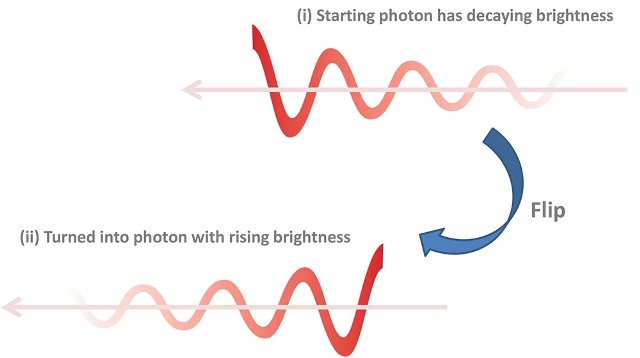Oct 20 2014
CQT's quantum mechanics have performed a new feat to get photons – the particles of light – into shape. The technique could prove useful for building devices that shuttle information between photons and atoms and back again. The work is described in a 15 October paper in Physical Review Letters, highlighted by the journal as an Editors' Suggestion.
 To use single photons to reliably send information into atoms, you need photons of the right shape. CQT researchers report in Physical Review Letters an elegant trick to flip a photon's shape by operating on another photon that's correlated with it.
To use single photons to reliably send information into atoms, you need photons of the right shape. CQT researchers report in Physical Review Letters an elegant trick to flip a photon's shape by operating on another photon that's correlated with it.
A good way to think about photons is as travelling packets of light waves. The amount of energy bundled into each packet is fixed, but the overall shape of the wavepacket is malleable.
CQT Principal Investigator Christian Kurtsiefer and his group members have demonstrated an elegant trick to shape a photon's wavepacket. They first create a pair of correlated photons, then adjust the shape of one by doing quantum engineering on the other.
As long ago as the 1930s, physicists predicted that photons emitted by atoms will have a particular shape. When an atom spontaneously drops from an excited energy level to a lower energy level, it emits a photon that has a strong front trailed by a dimming tail. The scientific description is that the photon shows exponential decay. The same maths says that atoms most efficiently absorb photons with the opposite profile, an exponential rise.
One reason that quantum physicists are concerned about the shapes of photons created and absorbed by atoms is because they imagine using these individual particles to carry individual information bits. The excited and ground state of the atom could represent the 1 and 0 of digital data, for example.
Communication systems today use pulses of light containing multitudes of photons, chanelling information to our computers with components containing multitudes of atoms. Scaling to individual particles is the ultimate limit of miniaturisation. In the particle realm, we can also harness quantum effects such as superposition to do computing in new, and sometimes dramatically faster, ways.
Previously researchers have re-shaped photons by an approach known as modulation: a brute-force method, where light is 'milled' away as the photons pass through a material with controllable absorption. Recently, researchers in Hong Kong reshaped photons in this way to be exponential risers, then showed they were absorbed almost perfectly into a cavity (see here). A cavity is formed by a pair of reflecting mirrors, and it can behave like an atom when interacting with single photons.
What Christian's team have done with their photons is more subtle. "We are engineering rather than imposing the shape. This approach has the advantage of not involving any energy loss," says team-member Alessandro Cere.
Graduate students Bharath Srivathsan and Gurpreet Gulati run an experiment that creates pairs of infrared photons as Rubidium atoms drop down from an excited energy level to an intermediate one, and then down to the ground state, in two quick steps. Together with Alessandro and Brenda Chng, they are working towards sending that second photon to another Rubidium atom and getting it to be absorbed.
The first photon produced as the Rubidium cascades down its energy ladder shows an exponential rise, the second photon shows a decay. (The shape of the photons was checked in an earlier paper.) Harking back to the discussion about photon shapes, this means the first photon is already in the best form to be absorbed by an atom. But the two photons have different energies and it's the second photon the team need, because it interacts with the atom energy levels most useful for quantum information schemes.
There is something special about the two photons from the Rubidium cascade. The two photons' arrival times are always correlated: this connection means that tweaking the temporal shape of one photon affects the shape of its entangled partner.
By sending the first photon into a cavity - its rising shape helps it in - the CQT researchers managed to flip both photon shapes. The cavity reverses the shape of the first photon into an exponential decay, and because of the photons' correlation, the shape of the second photon reverses too. The second photon then shows an exponential rise. The researchers haven't yet tried to get the reshaped second photon to be absorbed by another Rubidium atom, but they did test it in a cavity. They found that the reversed shape almost doubled the chances of the photon being successfully taken in, reaching 76%.
Before the team target Rubidium, the researchers face one more quantum engineering challenge. Although the photon now has the right overall form, it's still not entirely the right shape.
The experiment uses clouds of Rubidium atoms to create photons with wavepackets spread over some 5ns in time (about a meter in space), whereas a lone Rubidium atom prefers to produce and absorb photons about five times longer. The team's next photon-shaping step will be a stretch.
Source: http://www.quantumlah.org/